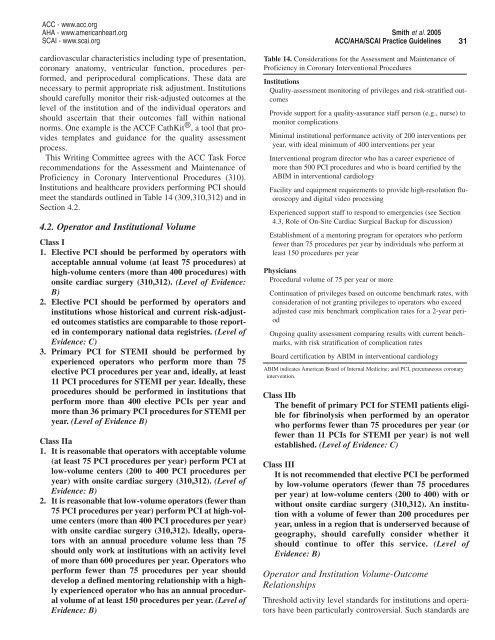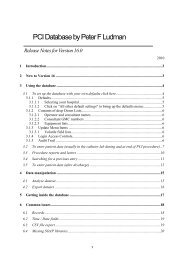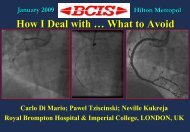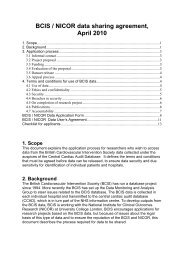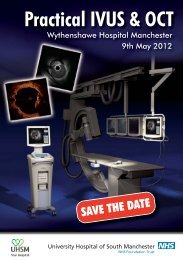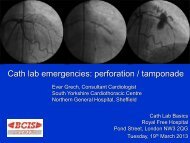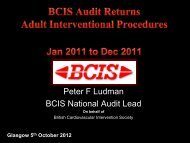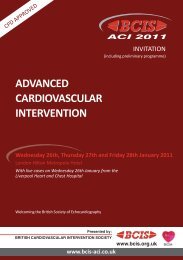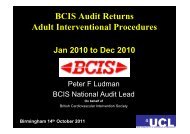Recommendations
ACC/AHA/SCAI PCI Guidelines - British Cardiovascular Intervention ...
ACC/AHA/SCAI PCI Guidelines - British Cardiovascular Intervention ...
- No tags were found...
You also want an ePaper? Increase the reach of your titles
YUMPU automatically turns print PDFs into web optimized ePapers that Google loves.
ACC - www.acc.org<br />
AHA - www.americanheart.org<br />
SCAI - www.scai.org<br />
Smith et al. 2005<br />
ACC/AHA/SCAI Practice Guidelines<br />
31<br />
cardiovascular characteristics including type of presentation,<br />
coronary anatomy, ventricular function, procedures performed,<br />
and periprocedural complications. These data are<br />
necessary to permit appropriate risk adjustment. Institutions<br />
should carefully monitor their risk-adjusted outcomes at the<br />
level of the institution and of the individual operators and<br />
should ascertain that their outcomes fall within national<br />
norms. One example is the ACCF CathKit ® , a tool that provides<br />
templates and guidance for the quality assessment<br />
process.<br />
This Writing Committee agrees with the ACC Task Force<br />
recommendations for the Assessment and Maintenance of<br />
Proficiency in Coronary Interventional Procedures (310).<br />
Institutions and healthcare providers performing PCI should<br />
meet the standards outlined in Table 14 (309,310,312) and in<br />
Section 4.2.<br />
4.2. Operator and Institutional Volume<br />
Class I<br />
1. Elective PCI should be performed by operators with<br />
acceptable annual volume (at least 75 procedures) at<br />
high-volume centers (more than 400 procedures) with<br />
onsite cardiac surgery (310,312). (Level of Evidence:<br />
B)<br />
2. Elective PCI should be performed by operators and<br />
institutions whose historical and current risk-adjusted<br />
outcomes statistics are comparable to those reported<br />
in contemporary national data registries. (Level of<br />
Evidence: C)<br />
3. Primary PCI for STEMI should be performed by<br />
experienced operators who perform more than 75<br />
elective PCI procedures per year and, ideally, at least<br />
11 PCI procedures for STEMI per year. Ideally, these<br />
procedures should be performed in institutions that<br />
perform more than 400 elective PCIs per year and<br />
more than 36 primary PCI procedures for STEMI per<br />
year. (Level of Evidence B)<br />
Class IIa<br />
1. It is reasonable that operators with acceptable volume<br />
(at least 75 PCI procedures per year) perform PCI at<br />
low-volume centers (200 to 400 PCI procedures per<br />
year) with onsite cardiac surgery (310,312). (Level of<br />
Evidence: B)<br />
2. It is reasonable that low-volume operators (fewer than<br />
75 PCI procedures per year) perform PCI at high-volume<br />
centers (more than 400 PCI procedures per year)<br />
with onsite cardiac surgery (310,312). Ideally, operators<br />
with an annual procedure volume less than 75<br />
should only work at institutions with an activity level<br />
of more than 600 procedures per year. Operators who<br />
perform fewer than 75 procedures per year should<br />
develop a defined mentoring relationship with a highly<br />
experienced operator who has an annual procedural<br />
volume of at least 150 procedures per year. (Level of<br />
Evidence: B)<br />
Table 14. Considerations for the Assessment and Maintenance of<br />
Proficiency in Coronary Interventional Procedures<br />
Institutions<br />
Quality-assessment monitoring of privileges and risk-stratified outcomes<br />
Provide support for a quality-assurance staff person (e.g., nurse) to<br />
monitor complications<br />
Minimal institutional performance activity of 200 interventions per<br />
year, with ideal minimum of 400 interventions per year<br />
Interventional program director who has a career experience of<br />
more than 500 PCI procedures and who is board certified by the<br />
ABIM in interventional cardiology<br />
Facility and equipment requirements to provide high-resolution fluoroscopy<br />
and digital video processing<br />
Experienced support staff to respond to emergencies (see Section<br />
4.3, Role of On-Site Cardiac Surgical Backup for discussion)<br />
Establishment of a mentoring program for operators who perform<br />
fewer than 75 procedures per year by individuals who perform at<br />
least 150 procedures per year<br />
Physicians<br />
Procedural volume of 75 per year or more<br />
Continuation of privileges based on outcome benchmark rates, with<br />
consideration of not granting privileges to operators who exceed<br />
adjusted case mix benchmark complication rates for a 2-year period<br />
Ongoing quality assessment comparing results with current benchmarks,<br />
with risk stratification of complication rates<br />
Board certification by ABIM in interventional cardiology<br />
ABIM indicates American Board of Internal Medicine; and PCI, percutaneous coronary<br />
intervention.<br />
Class IIb<br />
The benefit of primary PCI for STEMI patients eligible<br />
for fibrinolysis when performed by an operator<br />
who performs fewer than 75 procedures per year (or<br />
fewer than 11 PCIs for STEMI per year) is not well<br />
established. (Level of Evidence: C)<br />
Class III<br />
It is not recommended that elective PCI be performed<br />
by low-volume operators (fewer than 75 procedures<br />
per year) at low-volume centers (200 to 400) with or<br />
without onsite cardiac surgery (310,312). An institution<br />
with a volume of fewer than 200 procedures per<br />
year, unless in a region that is underserved because of<br />
geography, should carefully consider whether it<br />
should continue to offer this service. (Level of<br />
Evidence: B)<br />
Operator and Institution Volume-Outcome<br />
Relationships<br />
Threshold activity level standards for institutions and operators<br />
have been particularly controversial. Such standards are


